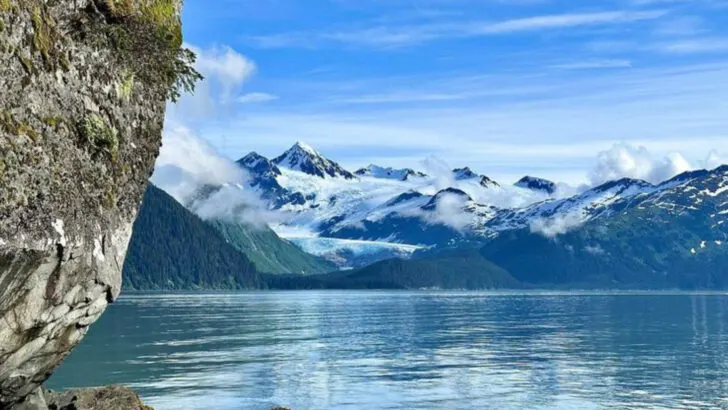They call it the “Norway of America”—but no one talks about it. Kenai Fjords National Park isn’t just off the beaten path. It’s practically hiding in the wilderness, surrounded by glaciers, whales, and mountains that look too dramatic to be real. You won’t find traffic jams or overpriced gift shops here. What you will find? Icebergs drifting like ghosts, bald eagles circling above black stone cliffs, and silence so pure it feels like its own soundtrack. This place is wild in the way national parks used to be—raw, remote, and breathtaking enough to make you forget your phone exists.
Sitka Spruce Along the Coastal Forests
The Sitka Spruce stands as a sentinel along the coastal forests of Kenai Fjords. These towering conifers, with their dark green needles and rough, scaly bark, thrive in the moist air from the sea. Their lofty branches, often cloaked in lichen, create an ethereal, mossy canopy. This tree, reaching impressive heights, provides shelter and sustenance to a diverse range of wildlife. Strolling beneath them feels like a journey through nature’s cathedral, where every step is cushioned by a carpet of fallen needles. Their resilience to harsh coastal winds makes them a symbol of strength and endurance.
Mosses and Liverworts That Soften the Forest Floor
Walking through the temperate rainforest zones of Kenai Fjords, visitors are embraced by a sea of green. Mosses and liverworts carpet the forest floor, creating a soft, sponge-like blanket. This lush undergrowth muffles footsteps, turning a hike into a tranquil experience. Every rock, fallen log, and tree trunk is adorned with this vibrant greenery, a testament to the area’s abundant moisture. This natural cushion fosters a unique ecosystem, supporting tiny organisms and contributing to the forest’s rich biodiversity. It’s a vivid reminder of nature’s resilience and the interconnectedness of life.
Wild Alaskan Blueberries Along Trail Edges
As summer wanes, Kenai Fjords transforms with the arrival of wild Alaskan blueberries. These low-growing bushes, found along sunlit trail edges, bear tart yet delectable berries. Their small leaves turn a striking rusty red with the onset of fall, painting the landscape with warm hues. Foraging these berries becomes a delightful pastime for both humans and wildlife. The blueberries, rich in antioxidants, offer a nutritious treat amidst the wilderness. This seasonal bounty symbolizes the park’s cycle of life and abundance, providing sustenance in the fleeting Alaskan summer.
Fireweed That Lights Up Glacial Valleys
Fireweed, with its vivid magenta flowers, is a beacon of color amid the glacial valleys of Kenai Fjords. Known as one of the first plants to repopulate after disturbance, it symbolizes renewal and resilience. The stalks bloom sequentially from bottom to top, marking the passage of summer. Locals say when the blooms reach the top, it signals the end of the season. This plant’s ability to thrive in such stark conditions showcases nature’s adaptability. Its presence not only beautifies the rugged terrain but also plays a critical role in the park’s ecological succession.
Dwarf Dogwood Nestled Beneath the Trees
In the shade of towering spruce and hemlock, the dwarf dogwood quietly thrives. Often called bunchberry, this low-growing plant spreads out beneath the forest canopy like a living tapestry. In spring, its crisp white flowers dot the landscape, giving way to clusters of red berries in fall. This plant’s presence adds a gentle, understated beauty to the forest floor. Its adaptability to thrive in the dim, moist conditions underlines the dynamic interplay of life within the park. The dwarf dogwood serves as a delicate reminder of nature’s subtle yet enduring charm.
Cotton Grass in the Wet Tundra Patches
Though it looks soft, cotton grass grows in cold, boggy soil and survives wind and frost. Its white, fluffy seed heads wave in the breeze across open meadows, offering one of the park’s more delicate visuals among rough terrain.
Devil’s Club in the Dense Understory
This spiky plant with large, palmate leaves grows tall and dense in moist forest areas, especially near rivers and creeks. Its thorn-covered stems and sprawling growth make it hard to move through—locals often call it “Alaska’s natural barbed wire.”
Arctic Willow in Windswept Areas
These shrubby willows hug the ground, shaped by freezing temperatures and constant wind. Look for them near alpine tundra zones, where their fuzzy leaves help them retain warmth and survive exposure.
Lupine That Adds Purple to Summer Slopes
During the brief summer bloom, lupine covers some hillsides and open fields with tall spikes of violet-blue flowers. Their presence helps fix nitrogen in the soil, preparing the land for other plants after glacial retreat.
Lichens That Paint the Rocks
Lichens cling to exposed boulders and glacial outcrops in shades of orange, green, and pale gray. They grow extremely slowly and are a reminder of how long this landscape has existed—and how much of it is shaped by patience and time.
Red Elderberry Shrubs in River Valleys
In midsummer, these shrubs produce clusters of bright red berries and tiny white flowers. They’re often found along creeks or in damp lowlands where sunlight filters through the canopy in patches.
Alpine Azalea in High-Elevation Meadows
This tiny, ground-hugging shrub has leathery leaves and small pink flowers that bloom close to the ground. It thrives in cold, rocky soil where little else grows, adding surprising color near snowfields or exposed ridges.
Yellow Paintbrush Dotted Among Tundra Plants
Not as common as the red variety found in other states, the yellow paintbrush adds soft pops of golden color to the subalpine meadows. Its irregular blooms peek out between dwarf shrubs and grasses, making it a cheerful surprise on backcountry hikes.

